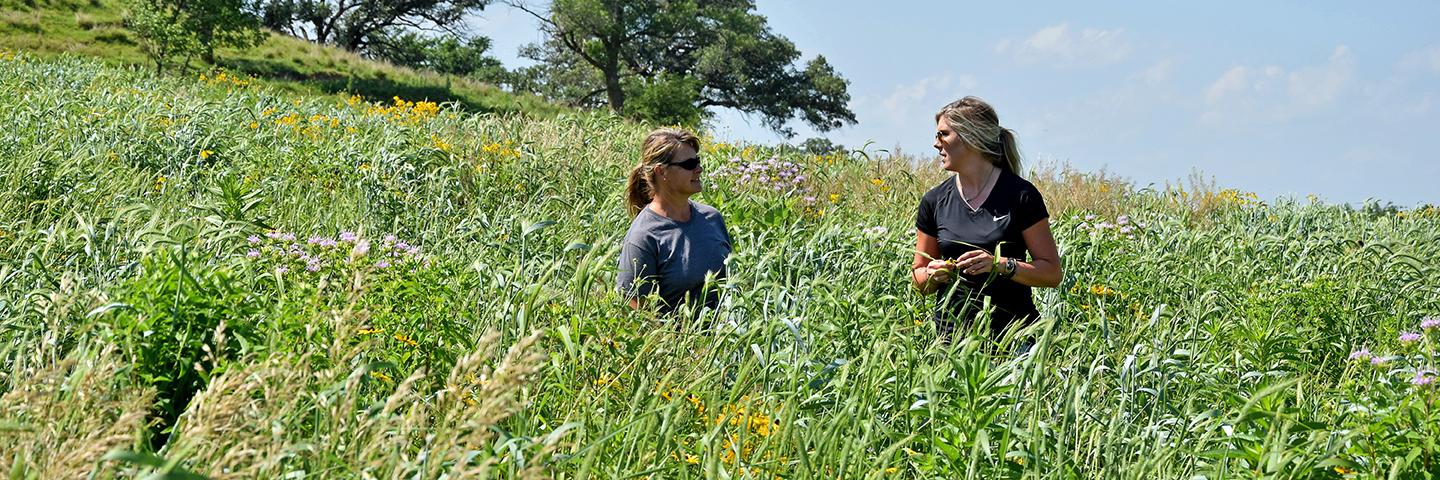Coffee Table Dreams Become Reality for Western Iowa Couple

A Monona County couple’s vision for the family farm is becoming reality thanks to a sound plan, a couple years of very hard work, and guidance and assistance from USDA.
A decade ago John and Molly Heaps worked full-time jobs. John was a full-time military and commercial pilot flying overseas flights. Molly was a registered nurse at a local hospital. Although they both enjoyed their careers, something was missing.
John and Molly found the perfect opportunity to get back to their farming roots when they purchased Molly’s family’s farm near Moorhead. Today, Molly works only on the farm and John continues to pilot commercial flights.
Their Loess Hills operation includes 417 acres of pasture, 130 acres of cropland, and 44 acres of native prairie through the Conservation Reserve Program (CRP).
Jackie Kragel, district conservationist with USDA’s Natural Resources Conservation Service (NRCS) in Monona County, says Molly visited the USDA Service Center in Onawa a few years ago with questions about her newly-enrolled CRP contract. At the time, Kragel was new to the Onawa office and hadn’t worked with the couple. “After we got to visiting, I learned much about their operation and her innovative ideas to improve conservation on her family farm,” said Kragel.
Since that meeting, Kragel has been heavily involved in providing efficient, practical, and affordable conservation solutions for John and Molly, beginning by helping the couple manage grazing for their 60 cow calf pairs.
New Watering Facility
A challenge for many Iowa graziers is getting cattle to utilize as much forage on as many acres as possible, particularly in the undulating Loess Hills. Molly says cattle sometimes use a creek or walk a mile just to get a drink of water, so the Heaps’ goal is to provide easier access to drinking water and keep cattle out of the creek.
Without electrical access on outer areas of the pasture, Kragel developed a livestock watering system that uses a solar powered pump, a deep well, and gravity-fed pipeline that delivers water to a 3,000-gallon storage tank and two tire tanks for water access.
NRCS provided financial assistance for a portion of the project costs through the Environmental Quality Incentives Program (EQIP), a voluntary conservation program that helps farmers achieve their agricultural production and environmental goals. To keep the additional costs down, the couple completed much of the construction themselves.
The project was near completion in July 2018. “(The watering facility) will balance forage consumption as we begin to rotationally graze,” said Molly Heaps, “and hopefully we’ll see weight gains from our cows, too.”
Kragel says setting up a managed grazing system is also good for local natural resources. Loess Hills soils are porous, lightweight, and erode easily if not properly protected. Healthy pasture helps prevent soil erosion and excluding livestock from the creek improves water quality. “(John and Molly) are extremely happy to have their coffee table dreams come to reality,” said Kragel. “They are now researching ways to implement a (multi-paddock) grazing system with NRCS help.”
Improving Pasture Conditions
In conversations with Kragel, the Heapses also expressed an interest in improving pasture conditions, including removing invasive eastern red cedar trees, managing weeds, and diversifying the forage.
To help improve pasture conditions Kragel encouraged John and Molly to sign up for the Conservation Stewardship Program (CSP), which pays producers for existing conservation efforts and requires implementation of additional activities to further strengthen their operation.
“We were interested in improving grass conditions to reduce fertilizer use,” said Molly. “We want to make this pasture more sustainable for our cow/calf pairs.”
Removing invasive eastern red cedar trees was one of the first projects John and Molly tackled through CSP. The cedars spread rapidly, cover and shade out beneficial plants and grasses which leaves the loose, crumbly loess soil susceptible to erosion. The trees have encroached on about 130 pasture acres. Removal requires cutting off the trees close to the base and burning them.
Molly says removing the trees is an ongoing battle but is very important to the future health of the pasture. “Everywhere there is a cedar tree, there’s grass that isn’t growing that a cow can’t eat,” she said.
Another way the couple is trying to reduce the need for extra feed is interseeding their pasture with warm season grasses. “We are trying to get a balance before we have to supplement feeding hay,” said Molly. “We hope to one day be able to quit supplementing our cattle with extra feed. CSP is helping us accomplish that goal.”
Cover Crops for Livestock Feed
In Fall 2017, the couple planted a cover crops mix of cereal rye, wheat and turnips on 30 corn acres for another source of livestock feed. John and Molly will plant cover crops on 30 acres for five years through their CSP contract.
They used the cover crops as a food source during the Spring 2018 calving season. “The cows loved it!” said Molly. “As they were grazing, they walked right down the cover crop rows toward us. Everything was very calm.”
“I was initially very skeptical about using cover crops for feed, but now I love it,” she said.
Molly is interested to see how soybeans yield this year after using cover crops. “This really is a test for us. We would like to do more cover crops for soil improvement, but we also want to see some results first,” she said.
Molly says she is confident all their hard work will pay off. “There’s something that gives back from the land around you when you take care of it,” she said. “I don’t know if everybody gets that off their land, but we do. This land is important to me. I want to preserve it for the next generation.”
- Photos (Flickr)

